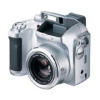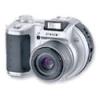
If the merchant wishes to have their inventory imaged, what kind of camera should I use? A digital camera... Seriously, any camera will do. The resolution of any digital camera on the market has always been at least 640 x 480 pixels. Images used by food-PORT are sized less than that. For best results, you should attempt to shoot at around 200 x 150. For more information, consult your food-PORT user documentation. When selecting a camera, two factors are important. First, there is price considerations, and second there is feature and usefulness considerations. Do not pay attention to digital zoom specifications of any digital camera. What's important is the optical zoom specs. Some cameras do not have an optical zoom capability. This is a kin to an instamatic film camera that does not have an adjustable lens. The implications are the same as with a film camera. It does not mean that you will take pictures that are less in quality or composition. It just means that you will have to control your environment in order to get a good shot. Obviously, the most important component in any camera, all other things begin equal, is the lens. Also, it helps if you see your subject through the lens, especially if you are shooting to get a very tight frame with a consistent border. If you are going to get a digital camera and quality and usefulness is the only consideration, then we prefer the following models:
Sony F828
Street price around $1100-$1200 USD
Takes Memory Stick. Best battery life by far of ANY digital. Lot's of great pictures
7X Optical ZoomNikon D70
Street price around $1200-$1500
CF Media. True SLR. Excellent battery life and best shutter lag.Sony F717
Street price around $650-$750 USD
Takes Memory Stick. Lot's of great pictures. Best battery life of ANY camera.
5X Optical ZoomMinolta dImage 7i
Street price around
$690.00-$900 USD
Very nice.
7X Optical Zoom
Fuji 3800
Street Price around
$300.00-$450.00 USD
Nicely priced for all the features
6X Optical Zoom
Sony MVC-CD250/400
Street price around
$390.00-$500.00 USD
Work Horse.
Saves to CD/CD-R
up to 1200 pics!!!
3X Optical Zoom
How long does it take to mount up a merchant? Without imaging, and if the merchant does not have an unusually extensive menu, and not considering administrative issues, about a day. With imaging, assuming all the product is available, on the average, it takes about 2 minutes or less per image, once your backdrop is setup and providing you have a decent digital camera and good lighting. The first time around, you should take a variety of test shots against different backgrounds, slightly different angles, etc, and publish to the web-portal. Pick one theme you like, and go.
What should I use to shoot images on? What color plates should be used? Use a warm neutral background. Make sure there is adequate lighting from multiple sources coming from all directions so no dominant shadows are formed. Shoot the object from a 50% degree angle into the background. You may try other angles, if you want. White plates may be used. Make sure there is contrast between the background, the product, and the plates.
Should I get a tripod? A tripod is not required, but will make things much easier and faster. A tripod can be acquired for around $20.00 to $50.00 USD.
Is imaging required by food-PORT? No. But it makes the ordering process more attractive and more complete. You may image some products, none of the products, or any combination thereof, and at any time after the initial mount.
How easy is it to attach pictures once they are taken? If you can figure out how to connect the camera to the PC and download the pictures from the camera, then you will think that the task of attaching the pictures to the product is a piece of cake, relatively speaking. The hardest part will be connecting the camera to the PC.
What browsers is eat2go food-PORT compatible with? eat2go food-PORT is compatible with Internet Explorer® 5 or greater and Netscape® 6 or greater. That represents almost 100% of all browsers used.
Are there any special settings that the user has to adjust on their browsers to use eat2go food-PORT? No. Not really. They should permit cookies, and they should run their screen resolution at 1024 x 768 or greater. However, 800 x 600 is fine. food-PORT will detect and adjust for the resolution.
What is browser caching? Caching is a concept a kin to learning by route in a biological organism. When we perform a task over and over again we tend to get faster at it, and we recall things without question. Once a computer performs any type of data reads, it has an option to save that data in a special area for faster retrieval if there should happen to be a next time that same data is requested. That is called a cache (pronounced cash). If a browser's cache is turned on, the browser will cache everything. Every page visited and every image that is seen by the user is saved in a designated local folder. Frequently, this data occupies a heck of a lot of storage. What that means is, if a browser visits a page next time around and detects an image of the same name, and also finds a copy of that image in its cached space, it will use its local copy instead of taking the time of downloading it, and then displaying it. The browser does the same thing with whole pages. If a local copy is present, that is what the user sees. There are implications to this type of "intelligence". If an image is changed by the web administrator, or worse yet, if a whole page has changed, you may not know about it because you may be seeing a local copy. For the most part, caching does not apply to food-PORT because the pages the user sees are generated by the server. They look like normal pages that a person would generate, but they are not. Caching rules and side-effects do apply to help screens and other static information. The page you are currently reading is subject to caching and its effects. If you are unsure if you are seeing a cached page, you may reload/refresh the page. In Internet Explorer® this is accomplished by right-clicking on the page and selecting "Refresh". You may also tune you browser's "intelligence" as far as caching is concerned. In Internet Explorer®, select "Tools", "Internet options" and "Settings". Select a setting of your choice. A good one, especially, if you have broadband, is "Every time you start Internet Explorer", providing you understand the implications of this selection.
What is HTML? HTML stands for (h)ypertext (m)arkup (l)anguage. It is a language that browsers read and based upon the interpretation, perform display and other activities. There are other "languages" that are used in conjunction to HTML. These are XML, Javascript, VBScript, ASP, PHP just to name a few.
What is a cookie? A cookie, or a stamp as it is sometimes appropriately called, is a discrete amount of information that is stored by a web-resident application on the users machine. Frequently this is done without the user even knowing about it. Some browsers implement storing of stamps in a single file while others store cookies in their own separate files. The latter method is more efficient because when a cookie is read, one does not have to scan through a file for the stamp. The cookie contains a name and other information, like a value, the domain name that sent the cookie, the stamped expiration date of the cookie, and a security flag. A cookie is a convenient way to store information for immediate or later retrieval. Based upon what a web-application finds in terms of a value of a specific cookie, certain actions could be performed. For example, a cookie may contain the number of times you visited a site. However, that value will only be applicable for a specific computer and a specific browser.
HOME
If you have a question you would like answered, please e-mail your query to: info@eat2go.com.
eat2go has no special affiliation with any of the manufacturers of digital equipment or any other equipment presented herein. The recommended herein products are suggestions rather than recommendations. We encourage you to read the Terms Of Use of eat2go websites.